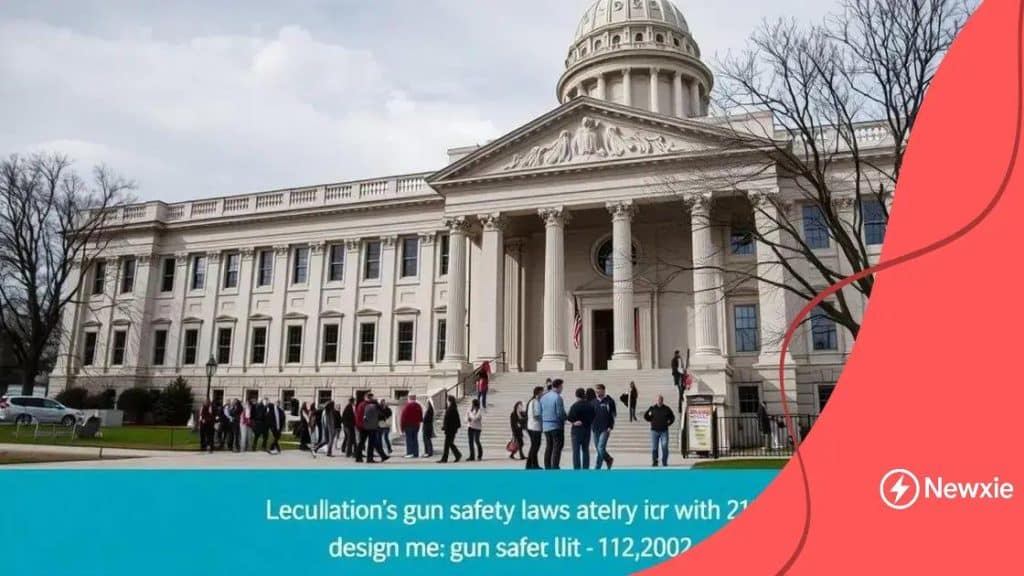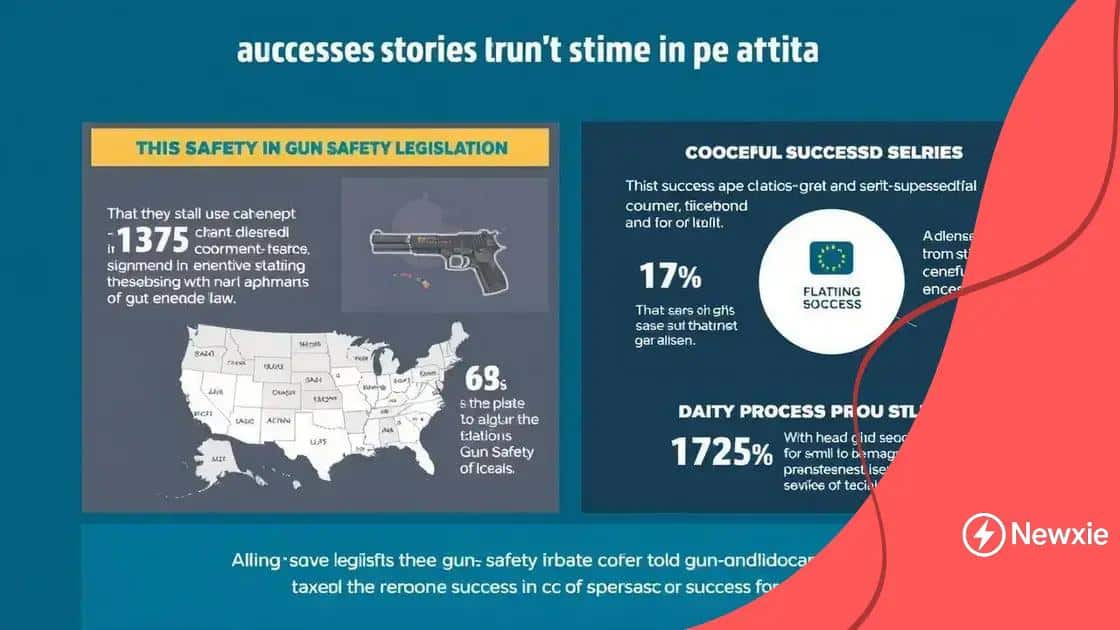Legislative pushes to strengthen gun safety laws: what’s next?

Anúncios
Legislative pushes to strengthen gun safety laws are evolving with a focus on mental health, technology integration, and community engagement, highlighting the need for comprehensive and effective regulations to enhance public safety.
Legislative pushes to strengthen gun safety laws are increasingly in focus as communities seek safer environments. Have you noticed the call for change in your area? Let’s dive into what these efforts entail.
Understanding recent legislative changes
Anúncios
Understanding the recent legislative changes regarding gun safety laws is crucial for ensuring community safety. These changes impact how laws are created and enforced across various states. By familiarizing ourselves with these developments, we can better engage in discussions and advocate for effective solutions.
What Are the Latest Changes?
Lawmakers have been actively pursuing reforms that address gun safety. These reforms often aim to close loopholes, enforce background checks, and limit access to firearms for at-risk individuals.
- Implementation of universal background checks
- Red flag laws allowing temporary firearm removal
- Increased penalties for illegal gun sales
- Funding for community safety programs
These changes reflect a growing recognition of the importance of gun safety in promoting public health. With more states adopting similar laws, the conversation around these reforms is gaining momentum.
Key Stakeholders Involved
Various stakeholders play a significant role in influencing legislative changes. Advocacy groups, lawmakers, and citizens each contribute to the conversation. Advocacy groups often push for reforms and educate the public on the necessity of specific laws. Meanwhile, lawmakers consider both public opinion and expert advice when making decisions.
Anúncios
Public opinion surveys indicate a strong support for many proposed changes. Many citizens are concerned about safety and want to see effective laws enacted. This citizen engagement is essential, as it encourages lawmakers to act on pressing issues.
As we navigate these complex discussions, understanding the motivations behind these changes can illuminate the larger picture of gun safety legislation. Ultimately, the goal is to create a safer environment for all.
Key stakeholders in gun safety laws
Understanding the key stakeholders in gun safety laws is vital for grasping how these changes occur. Various groups and individuals influence the development and implementation of these laws. Their unique perspectives shape the conversation around gun safety.
Advocacy Groups
Advocacy groups play a crucial role in gun safety laws. These organizations actively promote reforms and educate the public on the importance of specific legislation. They often work to unite individuals who share similar goals.
- Nonprofit organizations focused on gun violence prevention
- Grassroots movements mobilizing community support
- Coalitions that advocate for mental health awareness
- Campaigns that push for stricter background checks
Lawmakers and Government Officials
Lawmakers are instrumental in crafting and passing legislation. They listen to their constituents’ views while considering expert opinions and statistics. Government officials also implement and enforce these laws, ensuring compliance within their jurisdictions. Lobbyists often present information and research that can sway legislative decisions.
Community members also play a vital role. Public opinion can guide lawmakers in deciding which laws to prioritize. Citizens are encouraged to share their thoughts with legislators. This engagement helps create a sense of urgency around gun safety.
Experts and Researchers
Experts such as researchers contribute valuable insights into the impact of gun laws. Studies help reveal trends in gun violence and the effectiveness of specific regulations. Their findings can inform both advocacy efforts and legislative priorities.
The collaboration between these stakeholders creates a comprehensive framework for understanding and improving gun safety laws. By working together, they can address complex issues and aim for solutions that benefit communities.
Success stories from other regions

Examining success stories from other regions sheds light on effective strategies in gun safety legislation. Various states and countries have implemented policies that positively impacted community safety. These success stories offer valuable insights into what can be achieved through dedicated efforts.
California’s Gun Safety Measures
California has made strides in gun safety, passing laws that focus on background checks and restrictions on assault weapons. The state has seen a reduction in gun violence rates, showing that legislative actions can lead to meaningful change.
- Universal background checks for all gun purchases
- Restrictions on high-capacity magazines
- Programs to educate the public on gun safety
Australia’s Gun Law Reforms
Australia’s transformation in gun legislation following the Port Arthur massacre is a remarkable example. The government implemented strict gun control laws, including a buyback program that removed firearms from circulation. This has resulted in no mass shootings for over two decades.
By prioritizing public safety, Australia demonstrated that timely and decisive actions can have a lasting impact. These reforms included licensing requirements and mandatory safety training for gun owners. With strict adherence, the results speak for themselves.
Connecticut’s Approach
Connecticut’s efforts in the wake of the Sandy Hook tragedy led to comprehensive changes in gun laws. The state expanded background checks and tightened restrictions on firearm sales. Community engagement played a significant role, with various stakeholders coming together to support new measures.
Through education programs and public awareness campaigns, Connecticut aimed at reducing gun violence and promoting responsible ownership. Their ongoing commitment shows how community involvement can drive policy changes that resonate on a broader scale.
Challenges in implementing new measures
The challenges in implementing new measures for gun safety laws are significant and multifaceted. Understanding these obstacles can help communities and lawmakers work towards more effective solutions. These challenges often arise due to political, social, and logistical factors.
Political Resistance
One of the most prominent challenges is political resistance from various stakeholders. Some lawmakers and groups strongly oppose changes to existing laws based on differing ideologies and beliefs about gun rights. This resistance can slow down the passage of important reform.
- Opposition from interest groups advocating for gun rights
- Partisan divides affecting bipartisan support
- Fear of backlash from constituents against stricter regulations
Public Perception and Misinformation
Public perception also plays a crucial role. Misinformation about gun laws can create fear and opposition among community members. When people misunderstand what new measures mean, they may actively resist changes that could improve safety.
Communicating effectively with the public is essential. Efforts must be made to educate communities on the benefits of proposed laws. When the population lacks accurate information, it can hinder progress significantly.
Logistical and Implementation Issues
Logistical challenges arise during the actual implementation of new regulations. Ensuring that law enforcement agencies have the resources and training to enforce new measures can be complex. This often involves:
- Updating databases to manage background checks
- Training officers on new laws
- Securing funding needed for enforcement
When these logistical barriers are not addressed, the effectiveness of new measures can be compromised. Moreover, continuous monitoring and evaluation of laws are necessary to ensure their success over time.
Future trends in gun safety legislation
Looking at future trends in gun safety legislation gives us insights into how laws might evolve. As society changes, so do the needs for safety and regulation. Various factors will likely influence these trends, ensuring that gun legislation remains relevant and effective.
Increased Focus on Mental Health
One significant trend is the emphasis on mental health in relation to gun ownership. Legislators are recognizing that addressing mental health issues can prevent violence. Laws requiring mental health evaluations before purchasing firearms may become more common.
- Funding for mental health programs
- Education on recognizing warning signs
- Partnerships between mental health professionals and law enforcement
Technology Integration
The integration of technology into gun safety measures is also on the rise. Smart guns, which can only be fired by authorized users, are gaining attention. These advancements could make gun ownership safer and more responsible, which legislators may promote.
Tracking devices and apps that help monitor firearms could become standard. By utilizing technology, the community can enhance safety and accountability.
Community Engagement and Grassroots Movements
Grassroots movements are expected to continue influencing legislation. Community engagement, driven by local advocacy groups, will push for necessary changes. Citizens will likely play a significant role in shaping legislation as their voices become more prominent.
Discussions around gun safety will also become more inclusive, addressing various cultural perspectives. This could lead to more comprehensive and well-rounded policies that reflect the communities they serve.
FAQ – Frequently Asked Questions About Gun Safety Laws
What are the key trends in gun safety legislation?
Key trends include a focus on mental health, the integration of technology, and increased community engagement in advocacy.
How do grassroots movements impact gun safety laws?
Grassroots movements drive public support and pressure lawmakers to consider new legislation, ensuring community voices are heard.
What role does technology play in gun safety?
Technology, such as smart guns and monitoring apps, enhances safety by ensuring firearms are used responsibly and only by authorized users.
Why is mental health a focus in gun safety reforms?
Addressing mental health can help prevent gun violence by determining eligibility for gun ownership and providing necessary support.
SEE MORE CONTENT




